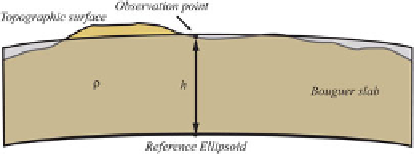Geology Reference
In-Depth Information
the distance
R
of the ellipsoid from the Earth's
centre:
LJ
LJ
LJ
LJ
rDR
C
LJ
LJ
LJ
LJ
rDR
C
:::
(14.50)
2
h
2
@
2
”
”.R
C
h/
D
”
0
C
h
@”
@r
1
@r
2
Fig. 14.5
Bouguer slab for the determination of simple
Bouguer anomalies
Dropping high-order terms and rearranging
gives:
LJ
LJ
LJ
LJ
rDR
Free-air anomalies are usually employed in
marine geophysics to analyze the tectonic struc-
ture of the sea floor, especially in oceanic regions,
where they furnish accurate representations of
spreading ridges, fracture zones, etc. (e.g., see
correlation with topography, because they do not
take into account of the presence of masses be-
tween the observation point and sea level. In
some sense, free-air anomalies show the grav-
ity anomalies that would be observed if all the
masses were condensed within the geoid. The
most simple correction that is performed to take
into account of the presence of masses above
the geoid is called
simple Bouguer correction
.
Let us assume that the topography of a region is
sufficiently smooth (Fig.
14.5
). In this instance,
we can approximate the mass above the geoid
by a homogeneous, infinitely extended slab of
constant thickness. The excess gravity generated
by an infinite slab of thickness
h
and uniform
density ¡ can be calculated starting from a thin
disk of thickness •
h
and radius
a
. To simplify the
calculation, it is convenient to choose a reference
frame with the origin coinciding with the disk
centre and with a
z
axis coinciding with the
symmetry axis of the disk. In this instance, the
volume element in the Poisson integral (
14.38
)
can be expressed in cylindrical coordinates as:
dV
0
D
dx
0
dy
0
dz
0
D
r
0
dr
0
d
¥
0
dz
0
.
Therefore, the potential at an arbitrary location
r
D
z
k
along the symmetry axis will be given by:
V.r/
D
G¡
Z
”
0
Š
”.R
C
h/
h
@”
@r
(14.51)
To first order, the derivative in (
14.51
) can be
estimated as follows:
LJ
LJ
LJ
LJ
rDR
Š
LJ
LJ
LJ
LJ
rDR
D
2
GM
LJ
LJ
LJ
LJ
rDR
GM
r
2
@”
@r
@
@r
r
3
2”
0
R
(14.52)
D
Therefore, substituting into (
14.51
)gives:
2”
0
h
R
”
0
Š
”.R
C
h/
C
(14.53)
The quantity:
2”
0
h
R
Š
0:3086
10
5
h
(14.54)
•”
FA
D
”
0
”.R
C
h/
D
is called
free
-
air correction
and represents the
adjustment that is required to take into account of
the elevation of the observation point. A
free
-
air
anomaly
is calculated from a raw gravity datum
subtracting the theoretical gravity at altitude
h
from the observed value at geodetic coordinates
(§,¥) and elevation
h
:
g
FA
.§;¥;h/
D
g.§;¥;h/
”
h
.§/ (14.55)
From (
14.54
), we have that these anomalies
can be calculated using the following canonical
expression:
1
j
r
r
0
j
dx
0
dy
0
d
z
0
R
Z
a
Z
2
Z
•h
d
z
0
j
r
r
0
j
g
FA
.§;¥;h/
D
g.§;¥;h/
”
0
.§/
C
0:3086
10
5
h (14.56)
r
0
dr
0
d¥
0
D
G¡
(14.57)
0
0
0




